Guam: Operations of the 77th Division, 21 July - 10 August 1944 (ENG)
Подождите немного. Документ загружается.

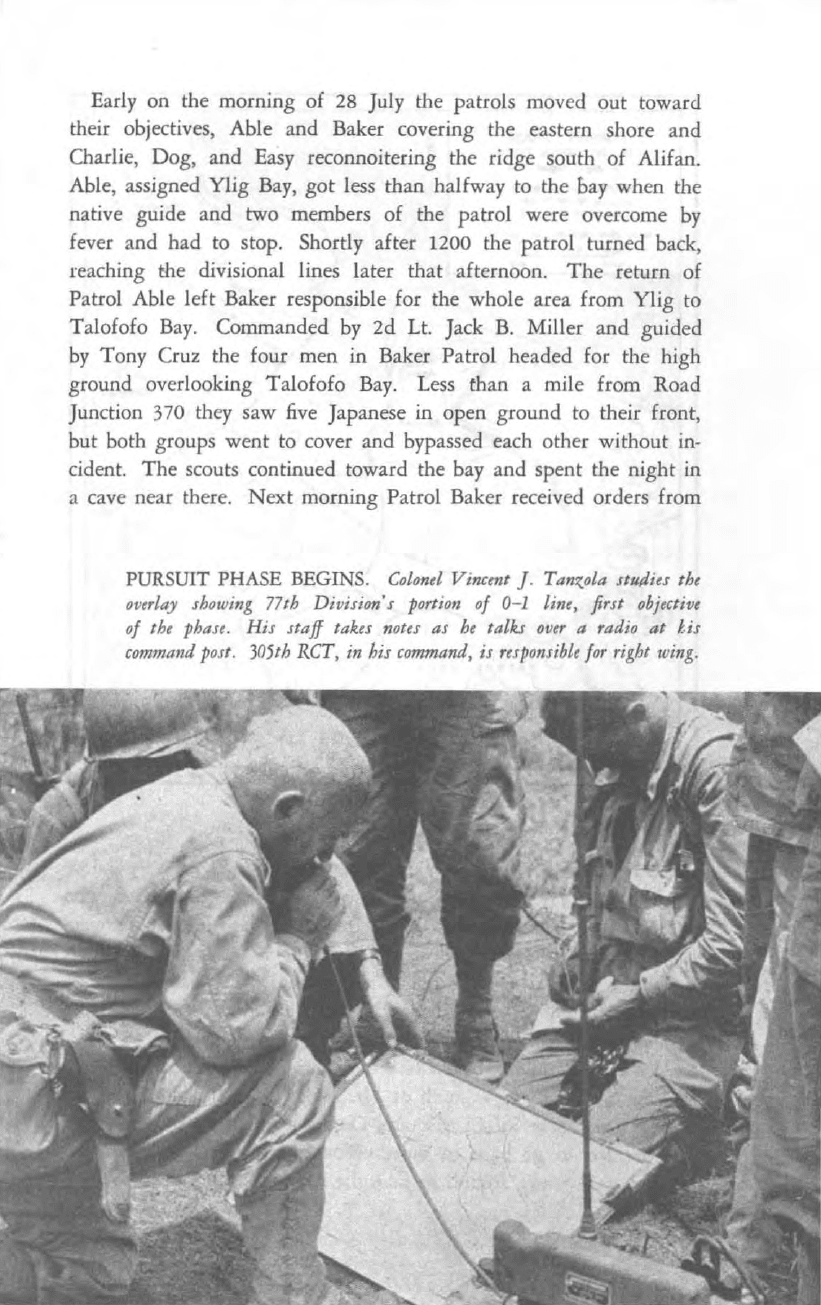
Early on the morning of
28
July the patrols moved out toward
their objectives, Able and Baker covering the eastern shore and
Charlie, Dog, and Easy reconnoitering the ridge south of Alifan.
Able, assigned Ylig
Bay,
got
less than halfway to the bay when the
native guide and two members of the patrol were overcome
by
fever and had
to
stop. Shortly after 1200 the patrol turned back,
reaching the divisional lines later that afternoon.
The
return of
Patrol Able left Baker responsible for the whole area from Ylig to
Talofofo
Bay.
Commanded
by
2d Lt. Jack
B.
Miller and guided
by
Tony Cruz the four men in Baker Patrol headed for the high
ground overlooking Talofofo
Bay
.
Less
than a mile from Road
Junction
370
they saw
five
Japanese in open ground
to
their front,
but both groups went
to
cover and bypassed each other without
in-
cident. The scouts continued toward the bay and spent the night in
a cave near there. Next morning Patrol Baker received orders from
PURSUIT PHASE BEGINS.
C%n.l
Vincmt
J.
Tan~ol"
stutiies
the
overlay showing 77th Division's portion of 0-1 line, jirJt objective
of the phasl. HiJ
JlajJ
take.r
notes
as
he
talL
over a radio
at
/:.is
command
post.
305rh
RCT, in his
command,
il
mponlibl,
for
right wing.
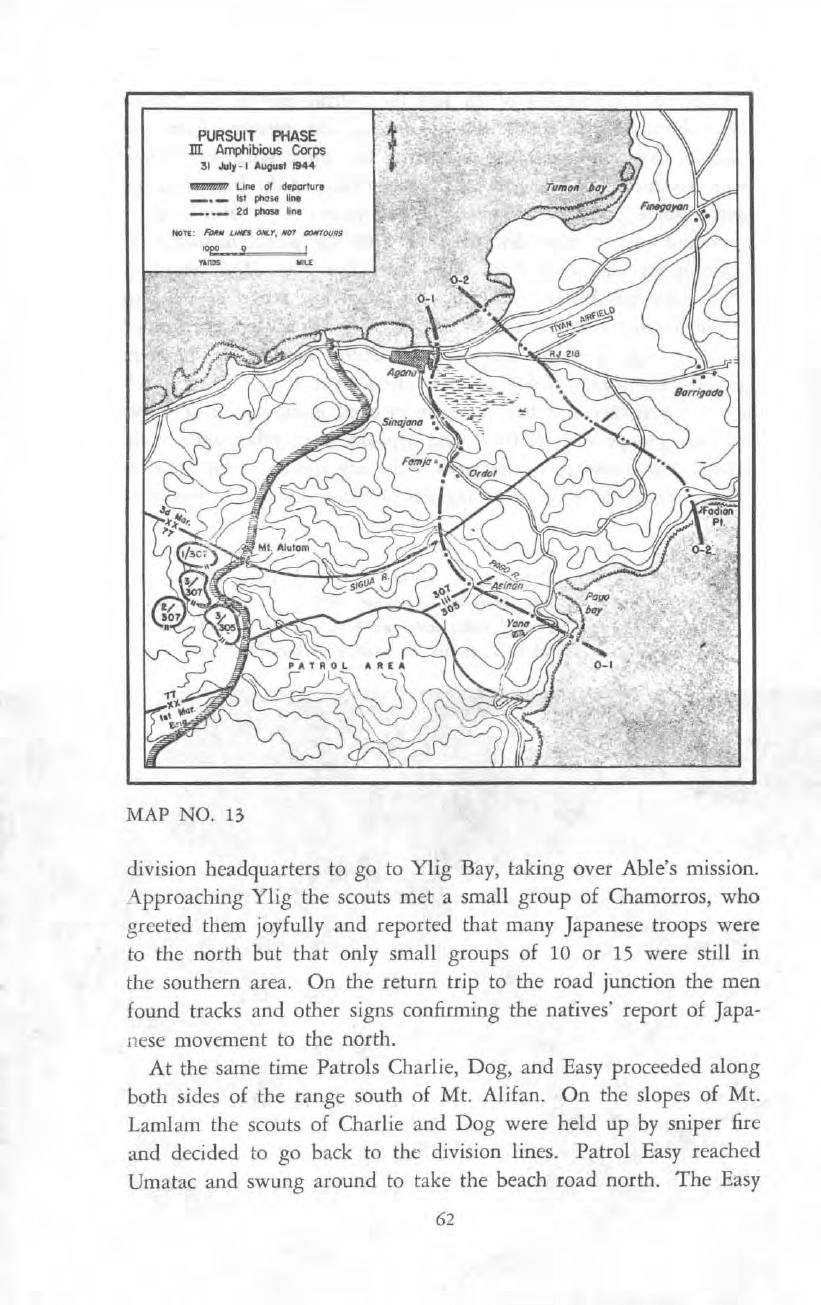
PURSUIT
PHASE
11[
Amphibious
Corps
31
July
-I
Augu.t
1M4
.....,
~
of
dtcIortur.
_._
111
pi'lcM
~ne
_
••
_
2d
phose
line
NOlt; RII/iI
uo;n
_~.
MtTT
~_
oago
!
-
~
MAP NO.
13
division headquarters to go to Ylig Bay, taking over Able's mission.
Approaching Ylig the scouts met a small group of Chamorros, who
greeted them joyfully and reported that many Japanese troops were
to
the north but
that
only small groups of
10
or
15
were still in
the southern area.
On
the return trip to the road junction the men
found tracks and other signs confirming the natives' report of Japa-
nese movement to the north.
At
the same time Patrols Charlie, Dog, and Easy proceeded along
both sides of the range south of Mt. Alifan.
On
the slopes of Mt.
Lamlam the scouts of Charlie and
Dog
were held up
by
sniper fire
and decided to go back to
the division lines. Patrol Easy reached
Umatac and swung around to take the beach road north.
The
Easy
62
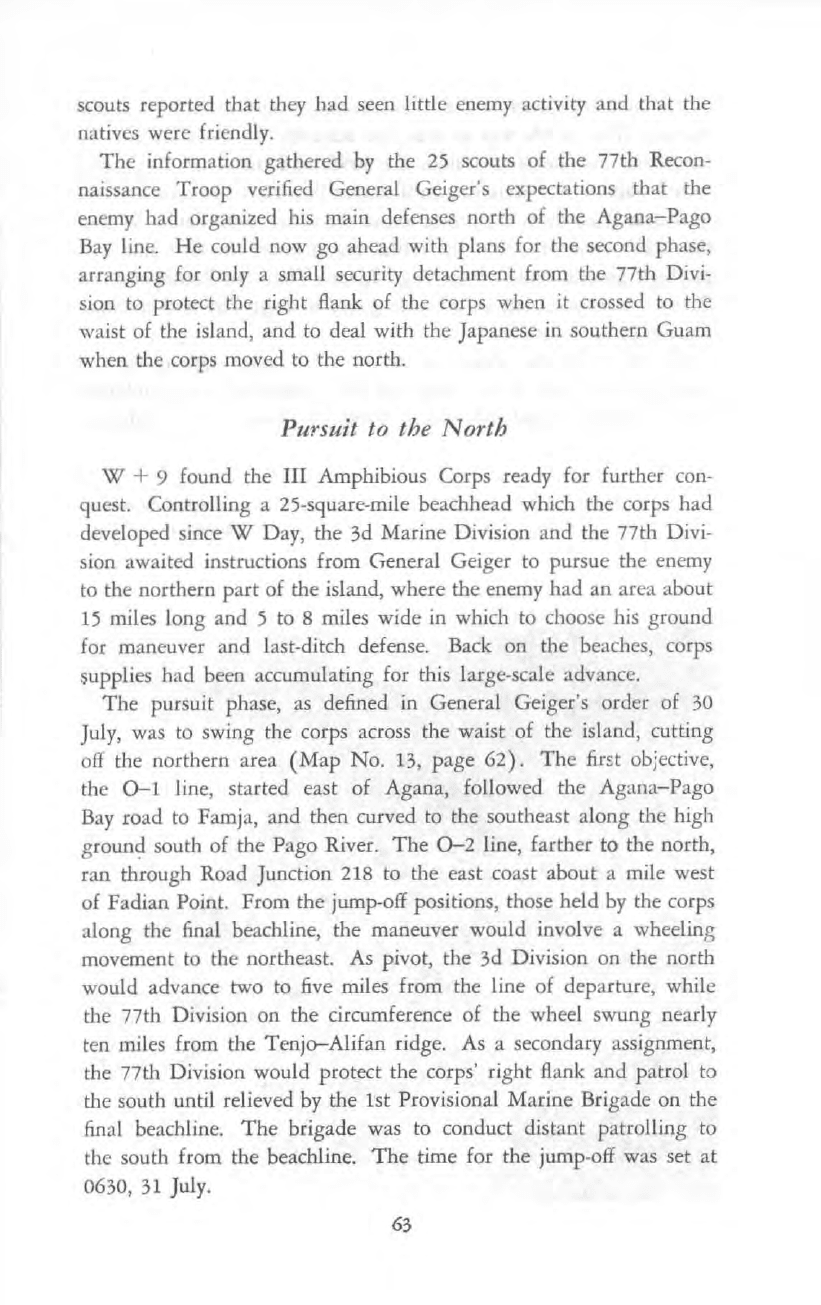
scouts reported that they had seen little enemy activity and that the
natives were friendly.
The
information gathered
by
the
25
scouts of the 77th Recon-
naissance Troop verified General Geiger's expectations that the
enemy had organized his main defenses north of the
Agana-Pago
Bay
line.
He
could now go ahead with plans for the second phase,
arranging for only a small security detachment from the 77th Divi-
sion to protect the right flank of the corps when it crossed to the
waist of the island, and to deal with the Japanese in southern Guam
when the corps moved to the north.
Pursuit to the
North
W + 9 found tl,e
III
Amphibious Corps ready for further con-
quest. Controlling a 25-square-mile beachhead which the corps had
developed since W Day, the 3d Marine Division and the 77th Divi-
sion awaited instructions from General Geiger to pursue the enemy
to the northern
part
of the island, where the enemy had
an
area about
15
miles long and 5 to 8 miles wide
in
which to choose his ground
for maneuver and last-ditch defense. Back on the beaches,
co
rps
supplies had been accumulating for this large-scale advance.
The
pursuit phase,
as
defined in General Geiger's order of
30
July, was
to
swing the corps across the waist of the island, cutting
off the northern area
(Map
No. 13, page
62).
The
first objective,
the
0-1
line, started east of Agana, followed the
Agana-Pago
Bay
road
to
Famja, and then curved to the southeast along the high
ground south of the
Pago River.
The
0-2
li
ne, farther to the north,
ran through Road Junction 218 to the east coast about a mile west
of
Faruan Point. From the jump-off positions, those held
by
the corps
along the final beachline, the maneuver would involve a wheeling
movement
to
the northeast. As pivot, the 3d Division on the north
would advance two to
five
miles from the line of departure, while
the 77th Division on the circumference of the wheel swung nearly
ten miles from the Tenjo-Alifan ridge. As a secondary assignment,
the 77th Division would protect the corps' right flank and patrol to
the south until relieved
by
the 1st Provisional Marine Brigade on the
final beachline.
The
brigade was to conduct distant patrolling to
the south from the beachline.
The
time for the jump
-off
was set
at
0630,
31
July.
63

All three regiments of the 77th Division would participate in the
pursuit.
The
307th was to lead the advance, followed in turn
by
the 305th and the 306th. Both the 305th and the 306th Regiments
would wait on the beachhead until the 1st
Provisional Marine Brigade
took over from them the protection of the corps' right flank.
Within
the 77th's 20ne of action the initial objective on the
0-1
line was
the high ground south of the
Pago River.
The
77th Reconnaissance
Troop was to send
out
an advance guard to Pago Bay and continue
patrolling to the south.
Operations of this phase for the 77th Division, working for the
first time on Guam
as
an integrated unit, presented major problems
of transportation and movement. From the Tenjo-Alifan ridge to
MACHINE-GUN NESTS
01l
the
final beachiine
are
occupied
by
men
of
J06th
Regiment. This unit held
the
FBL
during
adva""
to
0-1
Ii",
.
64
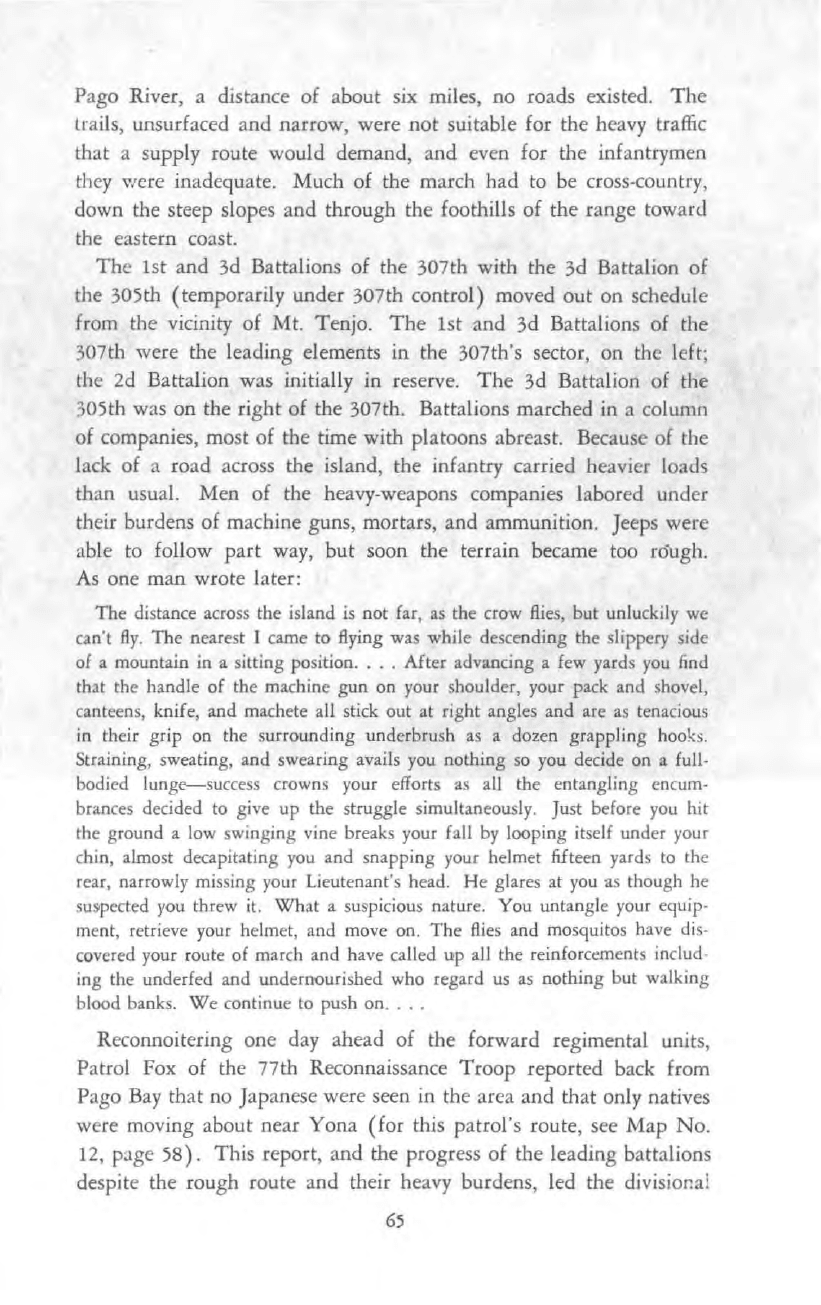
Pago River, a distance of about six miles, no roads existed.
The
trails, unsurfaced and narrow, were not suitable for the heavy traffic
that a supply route would demand, and even for the infantrymen
they
wcre inadequate. Much of the march had
to
be cross-country,
down the steep slopes and through the foothills of the range toward
the eastern coast.
Th
e 1st and 3d Battalions of the 307th with the
3d
Battalion of
the 305th (temporarily under 307th control) moved out on schedule
from the vicinity of Mt. Tenjo.
The
1st and 3d Battalions of the
307th were the leading elements in the 307th's sector, on the left;
the
2d
Battalion was initially in reserve.
The
3d Battalion of the
305th was on the right of the 307th. Battalions marched
in
a column
of
companies, most of the time with platoons abreast. Because of the
lack of a road across the island, the infantry carried heavier loads
than usua
l.
Men of the heavy-weapons companies labored under
their burdens of machine guns, mortars, and ammunition. Jeeps
werC
able
to
follow part
way,
but soon the terrain became too rough.
As
one man wrote later:
The distance ac
ro
ss the island
is
not
far
,
as
the crow flies, but unluckily
we
ca
n't
fly
. The nea
re
s
t]
came to
fiying
was while descending the slippery s
id
e
of a mountain in a
si
tting position .
..
.
Aft
er advancing a few yards
you
find
that
th
e handle
of
the machine gun on your shoulder, your
pa
ck and shovel,
canteens, knife, and
ma
chete all stick
Qut
at
right
an
gles and
are
as
tena
ci
ous
in
th
e
ir
grip on the surrounding underbrush
as
a dozen grappling hoo
ks.
Straining. sweating, and swearing avails you nothing so you decide on a full-
bodied lun
ge-s
uccess crowns your efforts as a
ll
th
e entangling encum·
brances decid
ed
to
give
up
th
e
st
ru
ggle
simultaneously.
Ju
st before
you
h
it
the grou
nd
a low sw
in
ging
vi
ne breaks yo
ur
fa
ll
by
looping
it
se
lf under your
chin, almost decapitating you and snapping your he
lm
et fifteen
yards
to the
re
ar, narrowly
mi
ssi
ng
your
Lieutenant's head. He g
lar
es
at
you
as though he
suspected you threw
it.
Wh
at
a suspicious nature. You untangle your equip·
ment, retrieve
your
helmet, a
nd
move on. The flies and mosquitos
ha
ve dis·
covered your route
of
mar
ch and have
ca
lled up all the reinforcements inclu
d-
ing the underfed and undernourished who
re
gard
us
as nothing but walking
blood
ba
nk
s.
We
conti
nu
e to push on .
...
Reconnoitering one day ahead of the forward regimental unit
s,
Patrol
Fox
of the
77
th Reconnaissance Troop reported back from
Pago
Bay
that
no
Japanese were seen in the area and that only nabves
were moving about near Yona (for this patrol's route, see Map No.
12
, page
58).
This report, and the progress of the leading battalions
despite the rough route and their heavy burdens, led the divisional
65

command
to
direct that they reach the
0-1
line south of the Pago
River that night.
An
artillery observation plane dropped General
Bruce's order
to
this effect.
Following these instructions, the 1st and 3d Battalions of the
307th and the
3d
Battalion of the 305th pushed ahead.
As
the
men of Company
I,
305th, commanded
by
Capt. Lee
P.
Cothran,
moved rapidly along the dirt road entering Yona from the
south-
west, they discovered that Patrol Fox had overlooked some enemy
troops in that village. The first two Japanese running across the
trail in front of the 2d Platoon
put
Company I on guard.
When
the platoon opened fire, the Japanese disappeared
in
dense brush
on the side of the road. Company
I's men moved forward under
66

CaMP
ANY
G,
30STH RCT moves
.
.Jouthea.st
of road
jUllCtiOtl
370
into
pOJition
for
the march across Guam.
G
follows J07th and units of J05th.
small-arms fire, and more Japanese were sighted runnmg hastily
among the grass huts
in
the town.
Facing continued scattered
fire from huts and pillboxes now visible
to the 2d
Platoon, the squads formed a skirmish line to sweep
through the enemy positions.
As
the 2d Platoon moved along
0"
a lSD-yard front, the squads lost contact with one another, but they
went about their work systematically, grenading the buildings and
shooting down their occupants with rilles and BAR's.
The
Japanese were evidently taken
by
surprise. Some of them
ran out of the buildings naked or half-dressed and made off for
the brush.
Others fired occasionally from dugouts and buildings
but then waited to be killed.
67
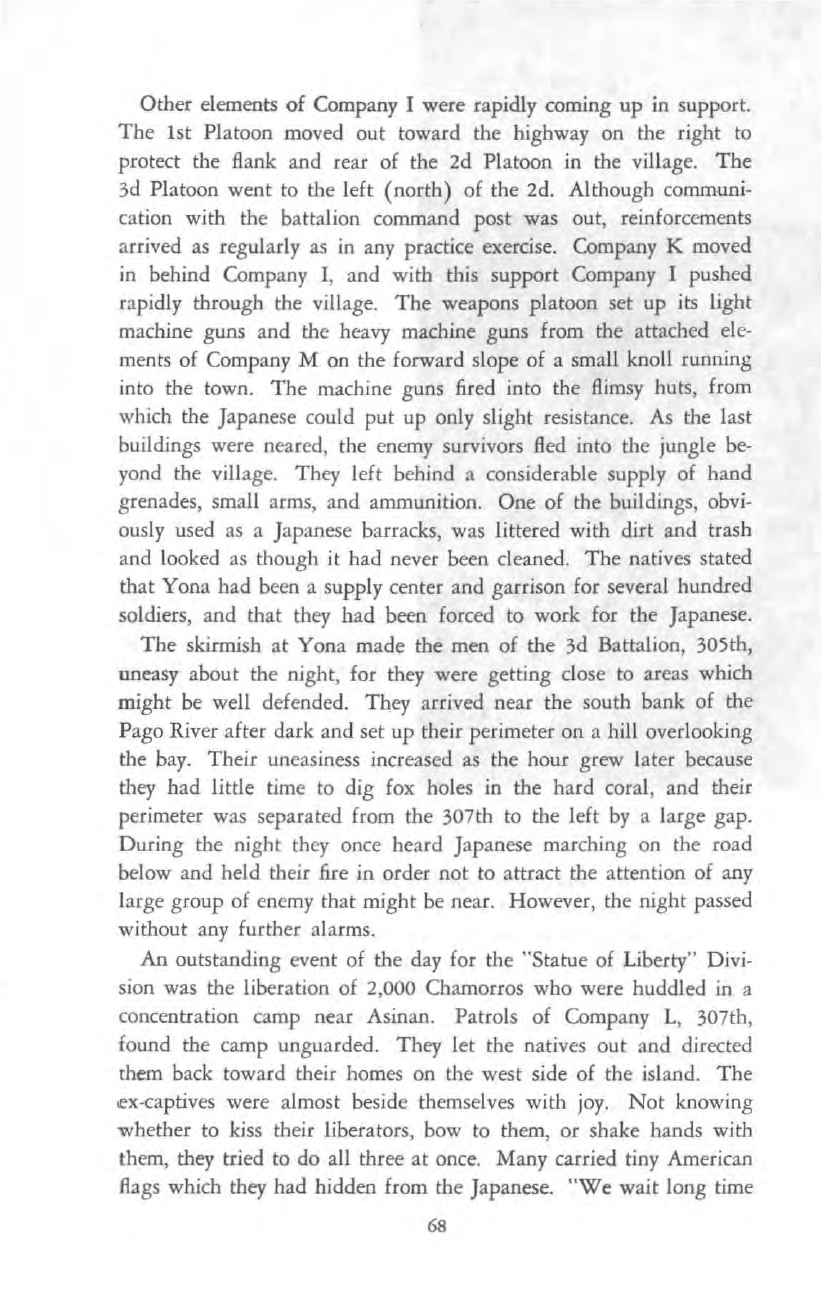
Other elements
of
Company I were rapidly coming up in support.
The 1st
Platoon moved out toward the highway on the right
to
protect the flank and rear of the
2d
Platoon in the village.
The
3d Platoon went to the left (north) of the 2d. Although communi-
cation with the battalion command post was out, reinforcements
arrived
as
regularly
as
in
any practice exercise. Company K moved
in
behind Company I, and with this support Company I pushed
rapidly through the village.
The
weapons platoon set up its light
machine guns and the heavy machine guns from the attached
ele-
ments of Company M on the forward slope of a small knoll running
into the town.
The
machine guns fired into the
flimsy
huts, from
which the Japanese could put up only slight resistance.
As
the last
buildings were neared, the enemy survivors
fled
into the jungle
be-
yond the village. They left behind a considerable supply of hand
grenades, small arms, and ammunition.
One of the buildings, obvi-
ously used
as
a Japanese barracks, was littered with dirt and trash
and looked
as
though it had never been cleaned.
The
natives stated
that Yona had been a supply center and garrison for several hundred
soldiers, and that they had been forced
to
work for the Japanese.
The skirmish
at
Yona made the men of the 3d Battalion, 305th,
uneasy about the night, for they were getting close
to
areas which
might be well defended. They arrived near the south bank of the
Pago River after dark and set up their perimeter on a hill overlooking
the
bay.
Their uneasiness increased
as
the hour grew later because
they had little time
to
dig fox holes
in
the hard coral, and their
perimeter was separated from the 307th to the left
by
a large gap.
During
th
e
ni
g
ht
they once heard Japanese marching on the road
below and held their fire in order not
to
attract the attention of any
large group of enemy that might be near. However, the night passed
without any further alarms.
An
outstanding event of the day for the "Statue of Liberty" Divi-
sion was the liberation of 2,000 Chamorros who were huddled in a
concentration camp near Asinan.
Patrols
of
Company L,
30
7th,
found the camp unguarded. They let
th
e natives out and directed
them back toward their homes on the west side of the island.
The
ex-captives were almost beside themselves with
joy.
Not
knowing
whether to kiss their liberators, bow
to
them, or shake hands with
them, they tried
to
do all three at once. Many carried tiny American
flags which they had hidden from the Japanese.
"We
wait long time
68
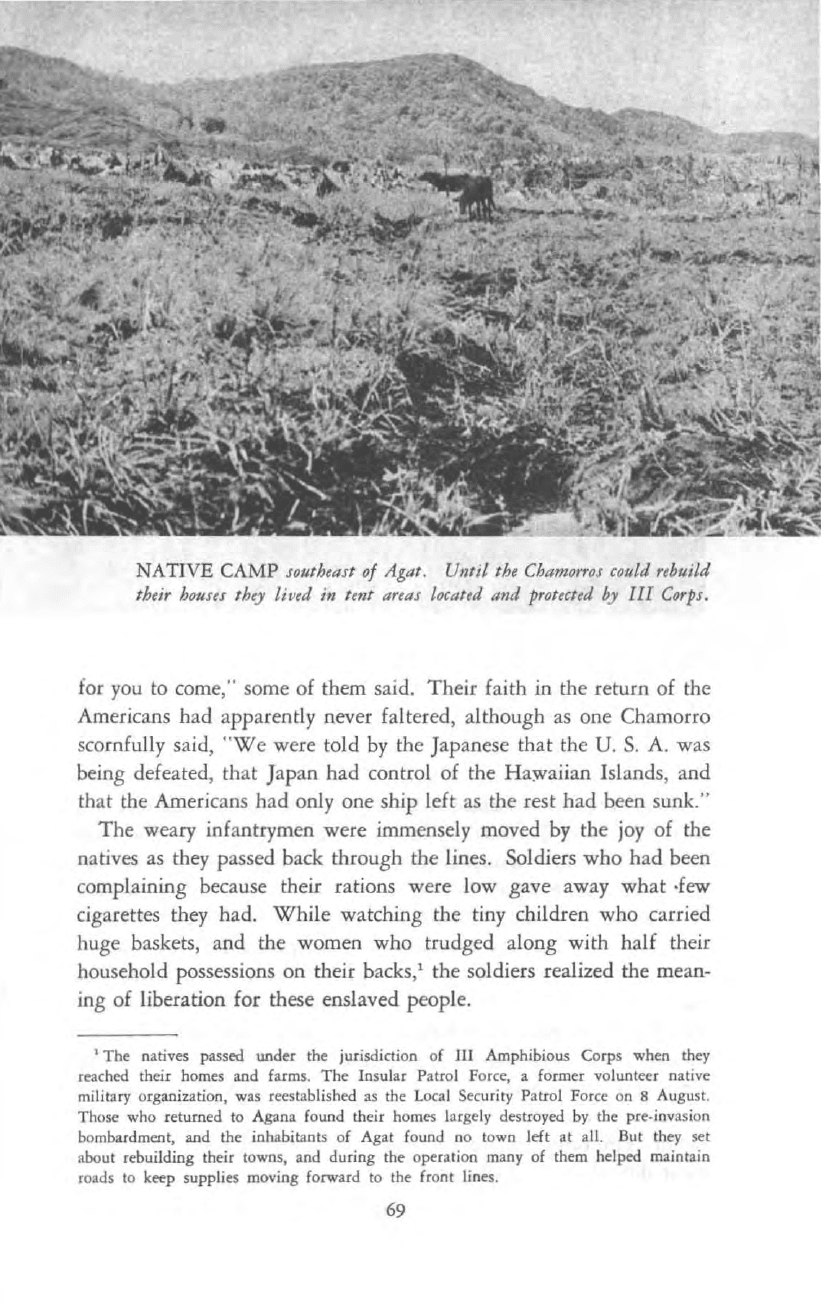
NATIVE CAMP southea" of Agat.
Until
the Chammos could rebuild
their
houses
they lived in tent areas located and protected
hy
III
Corps.
for
you
to
come," some of them said. Their faith in the return of the
Americans had apparently never faltered, although
as
one Chamorro
scornfully said,
"We
were told
by
the Japanese that the
U.
S.
A.
was
being defeated, that Japan had control of the Hay;aiian Islands, and
that the Americans had only one ship left
as
the rest had been sunk."
The weary infantrymen were immensely moved
by
the
joy
of the
natives
as
they passed back through the lines. Solcliers who had been
complaining because their rations were low gave away what
·few
cigarettes they had. While watching the tiny children who carried
huge baskets, and the women who trudged along with half their
household possessions on their backs,' the soldiers realized the mean-
ing of liberation for these enslaved people.
1
The
natives passed under the jurisdiction
of
III Amphibious Corps when they
reached their homes and farms.
The
Insular Patrol Force, a former volunteer native
military organization, was reestablished
as
the Local Security Patrol Force on 8 August.
Those
who
returned to Agana found their homes largely destroyed
by
the pre.invasion
bombardment,
and the inhabitants
of
Agat found
no
town
Jeft
at
aiL
But they set
about rebuilding their towns,
and
during the operation many
of
them helped maintain
roads to
keep supplies moving forward to the front Jines.
69
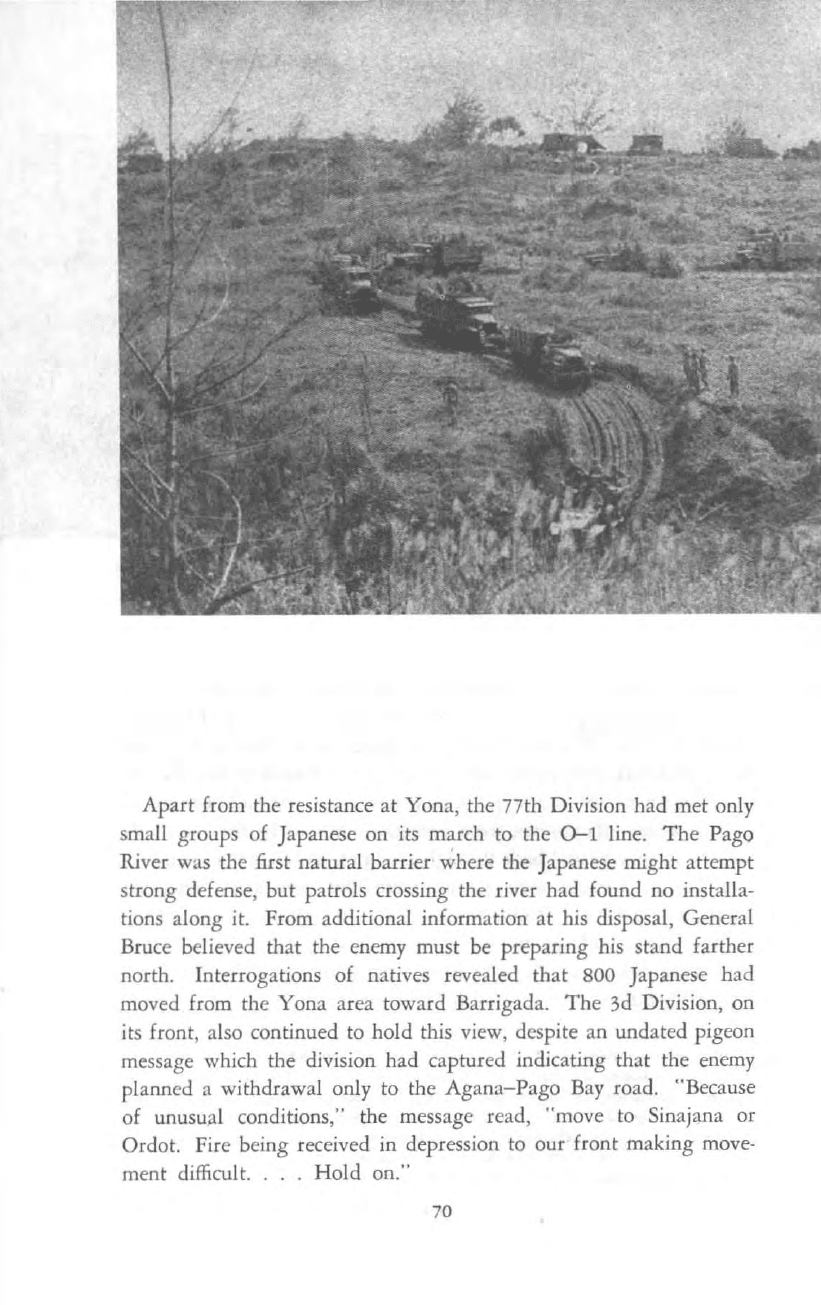
Apart from the resistance
at
Yona, the 77th Division had met only
small groups of Japanese on its march to the
0--1 line.
The
Pago
River was the first natural barrier where the Japanese might attempt
strong defense, but patrols crossing the river had found
no
installa-
tions along it. From additional information
at
his disposal, General
Bruce believed that the enemy must be preparing his stand farther
north. Interrogations of natives revealed that
800 Japanese had
moved from the Y ona area toward Barrigada.
The
3d Division, on
its front, also continued to hold this view, despite an undated pigeon
message which the division had captured indicating that the enemy
planned a withdrawal only to the
Agana-Pago Bay road. "Because
of unusual conditions," the message read, "move
to
Sinajana or
Ordot. Fire being received in depression to our front making move-
ment difficult
....
Hold
on."
70
